Xu Shen 許慎 (c. 58-c. 147), author of the Han-period 漢 (206 BCE-220 CE) dictionary Shuowen jiezi 說文解字, speaks of eight different writing styles (bati 八體) used during the Qin Period 秦 (221-206 BCE): the large seal script (dazhuan 大篆), small seal script (xiaozhuan 小篆), the carving script (kefu 刻符, used for inscriptions on seals and tallies, the "insects script" (chongshu 蟲書) or "birds-and-worms script" (niaochongshu 鳥蟲書, called so because of the appearance), the imprint copy script (moyin 摹印) used for inscriptions on the surface of seals showing how the seal imprint will look like), the appointment script (shushu 署書) used for inscriptions as document titles and on boards, the lances script (shushu 殳書) used for inscriptions on weapons, and the chancery script (lishu 隸書).
The problem with this categorization is that it is a mixed list of writings styles and of uses for different purposes.
A different concept has, for example, been used by the Yuan-period 元 (1279-1368) calligrapher Zhao Mengfu 趙孟頫 (1254-1322) in his work on the Qianziwen 千字文 "Thousand-Characters Classic", written in six styles, the Liuti qianziwen 六體千字文. The Qianziwen is presented in the styles of old script (guwen 古文), seal script (zhuan 篆), chancery script (lishu 隸書), [character]-isolating "grass script" (zhangcao 章草), standard script (zhenshu 真書), and "modern", connective grass script (jincao 今草).
There are a lot of different writing styles which can be reduced to a handful of main styles, namely the large seal script (zhoushu 籀書 or dazhuan 大篆), the small seal script (xiaozhuan 小篆), the chancery script (lishu 隸書), the standard script (kaishu 楷書), and the grass script (caoshu 草書).
The zhoushu zhouwen 籀文 (short zhou 籀) or dazhuan "large seal script", is an ancient writing style mainly used for and preserved in bronze vessel inscriptions. The term "large" seal script means that some characters were more complicated than in the later commonly used small seal script. The size of the characters was therefore also not equal. Complicated characters were larger, simple characters smaller. In the small seal script, all characters were written in equal size, regardless of the complexity.
The dictionary Shuowen jiezi from the Later Han period used an earlier character book, the Shizhoupian 史籀篇, to identify seal-script characters which had been simplified in the course of time, and comes to a sum of more than 200 characters that are of the large seal-script type. The invention of the Large Seal script was traditionally attributed to a person with the name of Shi Zhou 史籀, who lived during the reign of King Xuan 周宣王 (r. 827-782 BCE) of the Zhou dynasty 周 (11th cent.-221 BCE), but it rather seems that the term shizhou simply means "scribe".
The development of the ancient seal script to the smaller seal script begins in exactly the time of King Xuan. With the unification of the script in the whole empire in 221 BCE by the kingdom of Qin, the large seal script was quasi officially declared outdated, and the small seal script, as fixed by Counsellor-in-chief Li Si 李斯 (d. 208 BCE), became the standard seal script.
The characters of the modern script adopted a quadratic shape and a standardized form of all elements. Examples for this development are the inscriptions of the dish Guo Ji Zi Bo Pan 虢季子白盤, and the tripod Zong Fu Ding 宗婦鼎. This tendency continued in the following centuries, yet it differed from region to region. Interestingly enough, it was exactly the state of Qin where the old style survived the longest, as can be seen in the inscriptions of the bell Qin Gong Bo 秦公鎛, the tureen Qin Gong Gui 秦公簋, the bell Qin Gong Zhong 秦公鍾, the "Stone Drums" Shiguwen 石鼓文, the Zu chu wen 詛楚文, or the weight Shang Yang liang 商鞅量.
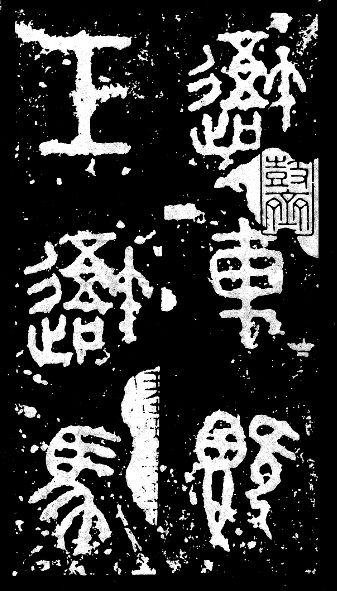 |
Example of large seal script from the "Stone Drum" inscriptions (shiguwen 石鼓文), from Guo 1982. |
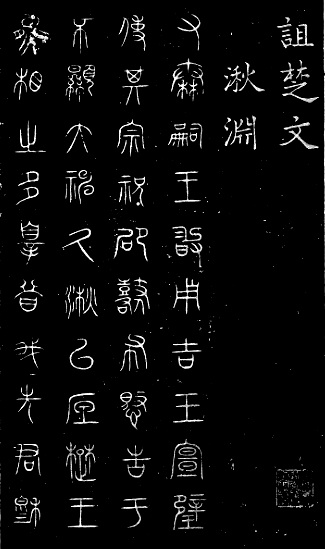 |
Example of large seal script from the "cursing of Chu" (zu Chu 詛楚) inscriptions, from Guo 1982. |
The term guwen 古文 "ancient script" is a designation for all writing styles that predated the common use of the chancery and the standard scripts with the foundation of the empire. In a narrow sense, the term means characters that were used in some of the Confucian Classics and that were outdated variants of those used from the Han period on. These Classics are said to have been written in seal-script style before the foundation of the Qin empire in 221 BCE and are thus commonly called the ancient-character classics (guwen jing 古文經, also translated as "old-text classics"). The new character texts (jinwen jing 今文經, "new-text classics") were written in the Former Han period 前漢 (206 BCE-8 CE) and were written in chancery script style.
The dictionary Shuowen jiezi includes more than 500 so-called "ancient script" characters that were used in the ancient-character classics. The term "ancient-script" characters is exclusively used for those used in the Confucian Classics excavated from the walls of the Confucius mansion where they had allagedly been hidden from the bloodhounds of the book-destroyer Li Si. All other old-type characters are called "large seal script characters", even if they are not necessarily more complex than those of the standard small seal script. The characters for "one" 一 and "two" 二, for example, were written 弌 and 弍 in the ancient script, but "throwing away" 棄 and "ritual" 禮 are written much simpler, namely 弃 and 礼.
The "classical" guwen characters can be seen as local variants of the region of Lu 魯 and Zou 鄒. In the past decades a lot of documents have been excavated that also show that local variants survived far into the Han period, like the silk inscriptions of Changsha (Changsha zengshu 長沙繒書), tallies from Houma (Houma mengshu 侯馬盟書) and Wenxian (Wenxian mengshu 溫縣盟書), the bamboo-slip inscriptions from Xinyang 信陽 near Jiangling 江陵, Hubei, the bronzes of the state of Zhongshan 中山 excavated in Pingshan 平山, Hebei, and the weapons of the state of Han 韓 found in Xinzheng 新鄭, Henan.
A much later document important for the study of the ancient script are the Stone Classics from the Zhengshi reign-period 正始 (240-248) which are written in three different styles (santi shijing 三體石經), namely ancient script, seal script and chancery script.
Some rare studies on the guwen characters were made by the Tang-period 唐 (618-907) scholar Lu Deming 陸德明 (c. 550-630) - see his Jingdian shiwen 經典釋文) - and the Song-period 宋 (960-1279) scholars Guo Zhongshu 郭忠恕 (d. 977), author of the book Hanjian 汗簡, and Xia Song 夏竦 (985-1051), who compiled the Guwen sisheng yun 古文四聲韻.
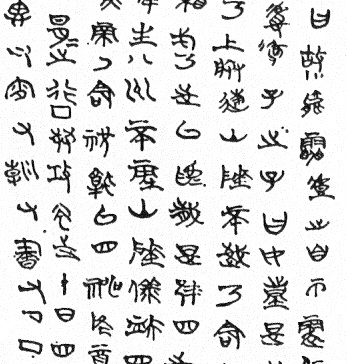 |
Example of a silk manuscript from Chu (Chu boshu 楚帛書), from Rao & Zeng 1993. |
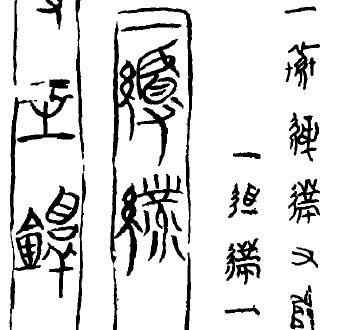 |
Some old-style characters from the bamboo slips of the state of Chu 楚 found in Xinyang, Hunan. From Zhu & Qiu 1973. |
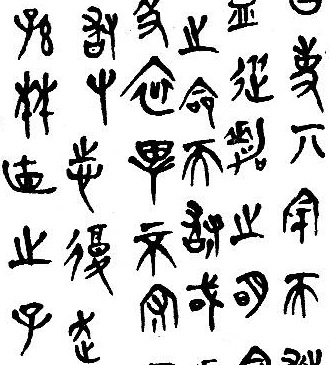 |
Part of the so-called "alliance tablets" discovered in Houma, Shanxi, written in old characters used in the state of Jin 晉. From Zhang 1966. |
The so-called birds-and-worms script (niaochongshu 鳥蟲書) is a special type of seal script in use from the 6th to the 2nd century BCE. It is also called niaoshu 鳥書 "birds script", chongshu 蟲書 "worms script" or yushu 魚書 "fish script". It is actually only a decorative calligraphic style which is not very appropriate for everyday use because of it is not very easy to read. All characters are given the shape of birds, fish, worms and insects. It is counted among the eight types of script used in the Qin empire.
The niaochong script was used for inscriptions in weapons, bells or other metal objects. The most famous examples are the halberd of Ziyu, [servant to the] king of Wu 吳王子于戈, the halberd of Sunyu, [i.e. Sima Ziyu 司馬子魚, servant to the] King of Chu 楚王孫漁戈, the halberd of Luan, [servant to] the king of Song 宋公欒戈, and many other objects mainly from the southern states of Yue 越, Chu, Wu, Song and Cai 蔡.
During the reign of the usurper Wang Mang 王莽 (r. 8-22 CE), it was revived for a short time. Emperor Ling 漢靈帝 (r. 167-188) of the Later Han period appointed scholars to investigate the niaochong script. Calligraphers of the Qing period 清 (1644-1911) were again interested in the birds-and-worms script and occasionally made use of it.
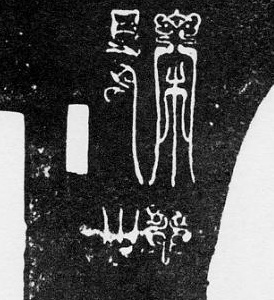 |
"Bird-and-worms characters" inscription on a halberd from the state of Song, from Zhongguo shehui kexue yuan kaoguxue yanjiusuo 1984, no. 11132. |
The term "seal script" is the designation for a writing style that had been common during the whole Zhou period but that lost its importance as a script style in daily life from the late Warring States period 戰國 (5th cent.-221 BCE) on. From that time on it was only used for important inscriptions, like seals, tallies, coins, weights and measuring tools, boards, and so on. The name is thus a retrospective term that came up during the Han period. The small seal script is the standard seal script even in modern calligraphy and seal carving.
The small seal script is a product of character simplification that had taken place in the state of Qin. When Qin founded the empire in 221 BCE, its seal script, as well as the chancery script, the precursor of the modern script, were taken over as the national standard. The invention of the Small Seal Script is attributed to the counsellor Li Si, who is said to have ordered the compilation of the character glossaries Cangjiepian 倉頡篇, Yuanlipian 爰歷篇 and Boxuepian 博學篇, which are all lost today, except a few fragments.
Already at that time, the seal script was outdated and not any more used in daily life. Examples of the Qin small seal script are preserved in the stone inscriptions of Mt. Taishan 泰山 (Shandong), Langya 琅琊 (Shandong), Mt. Yishan 嶧山 (Shandong) and Guiji 會稽 (Zhejiang), as well as in many weights and measuring tools unearthed from all places of China.
Han-period small seal script is preserved in the dictionary Shuowen jiezi, compiled in the 2nd cent. CE. This dictionary is very important because the small seal script is a very useful tool to analyse the composition and original meaning of the characters, as well as the phonetic elements in the Chinese script. Later styles, like the chancery script (lishu) or standard script (kaishu), have abbreviated parts of characters so that the original appearance has become lost. For Han-period scholars a listing of small seal-script characters was important because some versions of certain Confucian Classics had been transmitted in "ancient script" (guwen).
Another important source for the small seal script are the so-called Stone Classics (shijing 石經) from 243, an inscription of Confucian Classics into stone tablets, with the whole text being written in three different writing styles, namely seal script, ancient script (or large seal script) and chancery script.
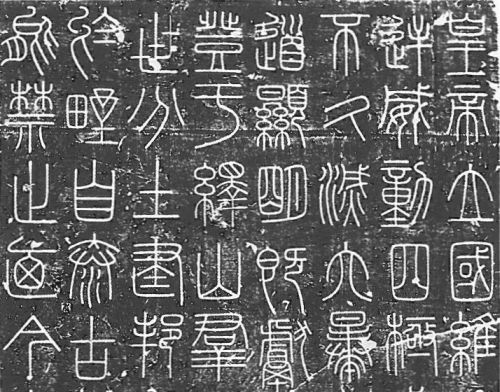 |
Inscription of the Qin-period stele of Mt. Yishan. Zhonguo meishu quanji bianji weiyuanhui 1: 22. |
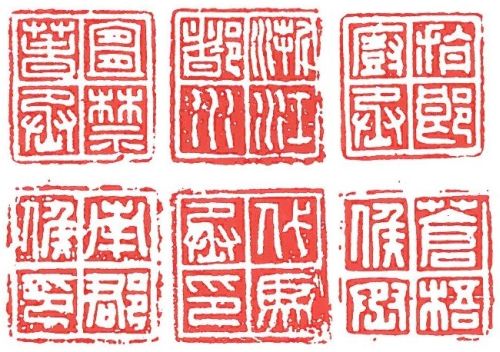 |
Former Han-period seals. From Huang & Zhuang 1999. |
The chancery script (lishu 隸書) is the standard script to be used for everyday communication to be written with the brush. It is commonly divided into Qin-period lishu (or "old chancery script", guli 古隸), Han-period lishu, and the bafen 八分 style. It was the direct precursor of the standard kaishu style, from which the modern writing style developed. This "modern chancery script" (jinli 今隸) is also called "Kaiyuan script" (kaiyuan wenzi 開元文字) because it wasre-standardized during the Kaiyuan reign-period 開元 (713-741) of the Tang period.
It is commonly assumed that the kingdom of Qin, in which a relatively archaic writing style was used, was the first to systematically simplify characters for the sake of easier writing for bureaucratic needs. The simplification of characters is attributed to Cheng Miao 程邈, an official of King Zheng, the eventual First Emperor 秦始皇帝 (r. 246-210 BCE), yet is is not known if the result of his simplifiction was the small seal script or already the chancery script. Archaeological evidence proved that the chancery script was already in use before the reign of the First Emperor. Weapons and pottery from the state of Qin are inscribed with simplified characters that are the precursors of the chancery script. The texts written on the bamboo slips found in Shuihudi 睡虎地, dated from the imperial Qin period, are written in mature chancery script.
While the chancery script was used in buraucracy and communication, the small seal script continued to be used for inscriptions with a ceremonial and legislative relevance, like the inscriptions on weights and measures. The chancery script was quite similar to the writing styles of the other regional states of the Warring States period and could therefore easily be used as a national standard script with the unification of the empire in 221 BCE.
The chancery script is, compared to the seal script, much more edgy and square, and all characters are roughly written of equal size. This tendency became even more prevalent during the Former Han period. The bafen style is characterized by thick brush strokes, characters that are wider than high, and by the typical "squat feet" like the characters 八 and 分 that gave the style its name.
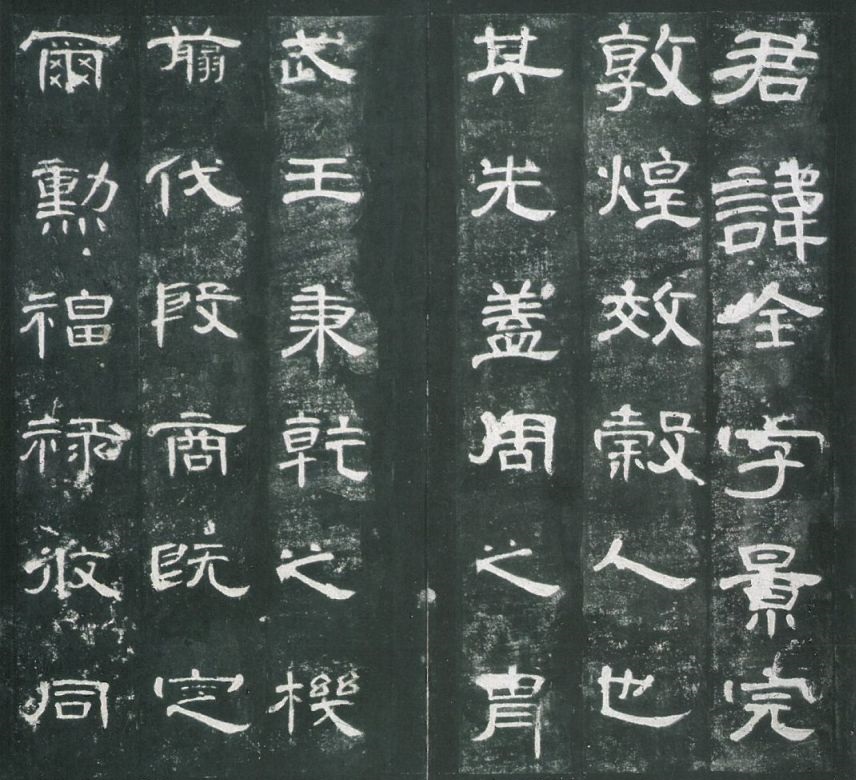 |
Example from the stone stele dedicated to the memory of Cao Quan 曹全 (Cao Quan bei 曹全碑) and dated 185 CE, written in lishu style. Zhongguo meishu quanji bianji weiyuanhui 1: 172, no. 100. |
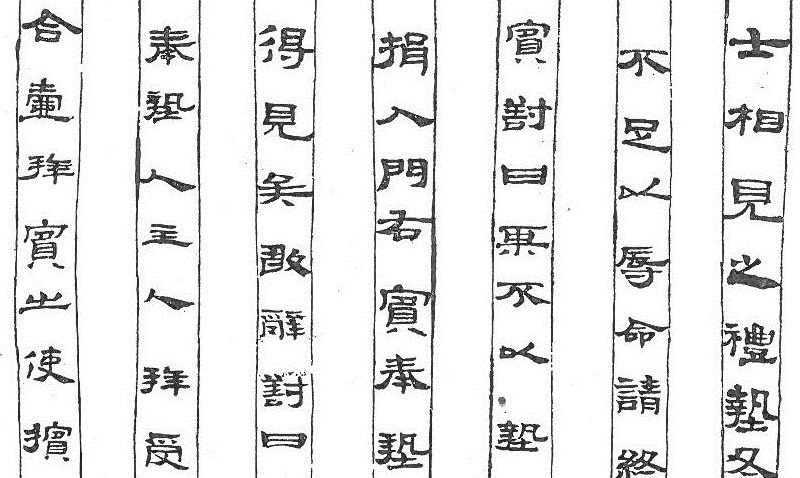 |
Example from Han-period bamboo slips found in Wuwei 武威, Gansu, written in bafen style. From Gansu Sheng Bowuguan & Zhongge Kexueyuan Kaogu Yanjiusuo 1964. |
The bafen 八分 style is a special ductus of the chancery script from which later the kaishu style emerged. The bafen style is easily to identify by the typical squareness of the characters that caused contemporary scholars to speak of cantou 蠶頭 "silkworm heads", yanwei 燕尾 "swallow tails", or bafen 八分 (literally "eight-division"), referring to the "squat ends" of the brush strokes of these typical characters. It became standard during the Later Han period and can be admired in its most famous example, the Xiping stone inscriptions of seven Confucian Classics.
The change of the slim and vertically written ancient writings styles to the more horizontal and square type of the bafen was seen as a crucial development in the writing style, even by contemporarians. The quadratical appearance of Chinese characters (fangkuai 方塊) is indeed a heritage of this change. Tang-period scholars had apparently forgotten that the script had not always been squarish and could not explain statements from the Han period that the bafen was a change of the "old" (narrow) script and tried to explain the name bafen by the size of characters (eight millimetres) or other methods. The bafen is often called a first stage of the kaishu style. Wang Cizhong 王次仲 is believed to have been the inventor of the real kaishu.
The kaishu 楷書 "model script", also called zhenshu 真書 "perfect script" or zhengshu 正書 "correct script", is the standard script of the Later Han period from which the modern printing fonts are derived. It has been developed out of the bafen ductus of the chancery script (lishu). Wang Cizhong 王次仲 is sometimes called the inventor of the kaishu style, while it was perfected by Zhong Yao 鍾繇 (151-230). The oldest traces of the kaishu script has been found in archival documents detected in Chinese colonies in the West. A kaishu-style script is also to be found in inscriptions on pottery from that period. Yet the stone stelae erected in 178 CE which were inscribed with the texts of the Confucian Classics (the Xiping stone classics 熹平石經) still use the bafen style. This shows that the kaishu style has been developed by daily use, while the lishu was still the official and more ceremonial writing style.
From the Wei period 曹魏 (220-265) on the kaishu style was also used for official documents, like the stele Gu Lang bei 谷朗碑 from 272 and the Hengyang taishou Ge Zuo bei 衡陽太守葛祚碑 from the Jin period 晉 (265-420). During the Southern Dynasties period 南朝 (420-589), the name kaishu was used for the bafen syle of the Later Han period, while the term zhenshu referred to the style used in documents and for textbooks of elementary learning. The style that had developed to the common standard style (what we today call kaishu) was then officially called zhengshu "correct style".
Tang-period scholars saw the kaishu as a kind of derivate of the lishu style and therefore called the famous Jin-period calligraphers like Wang Xizhi 王羲之 (307-365), Wang Xiangzhi 王獻之 (344-386), Zhong Yao and Zhang Zhi 張芝 (d. 192 CE) "masters of the lishu". Calligraphers like Zhiyong 智永 (who wrote Zhenshu qianziwen 真書千字文) or Ouyang Xun 歐陽詢 (557-641, famous for his Liquanming 醴泉銘) refined the zhengshu (kaishu) and were therefore later often called the creators of the kaishu.
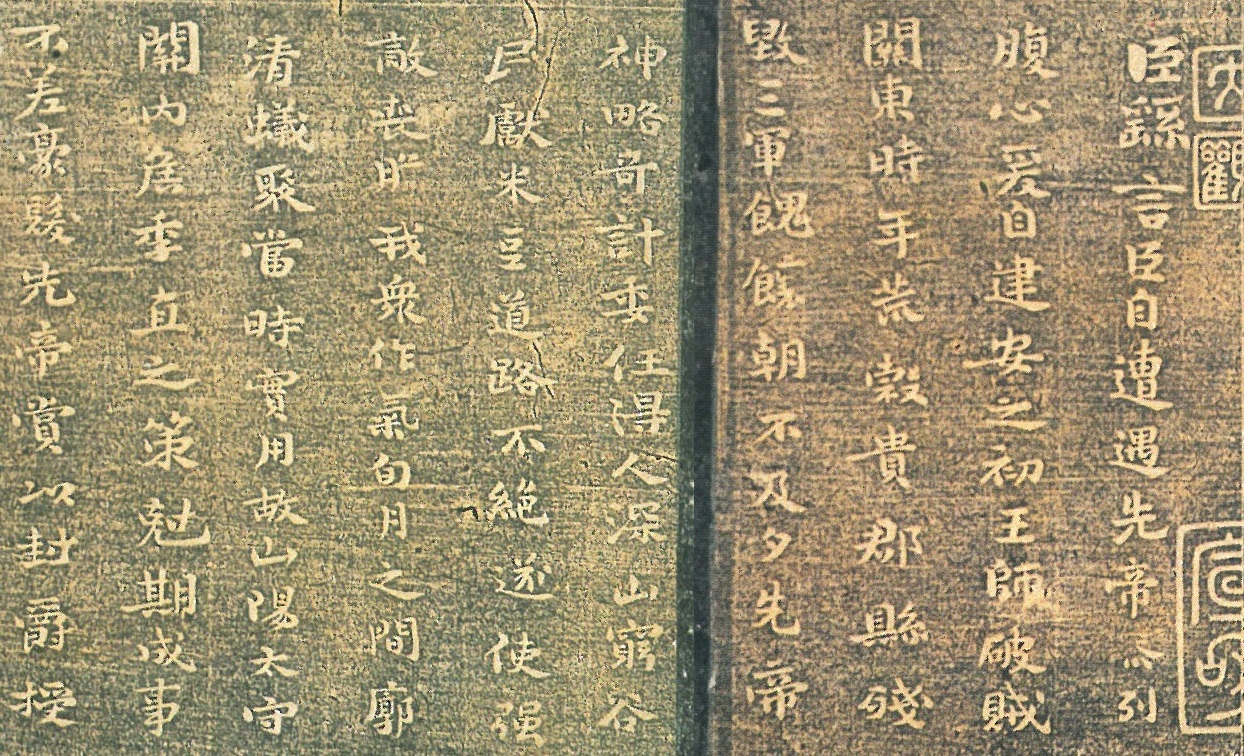 |
Reproduction of Zhong Yao's 鍾繇 Jian Jizhi biao 荐季直表 from the Zhenshang Studio 真賞齋. Zhongguo meishu quanji bianji weiyuanhui 2: 18, no. 14. |
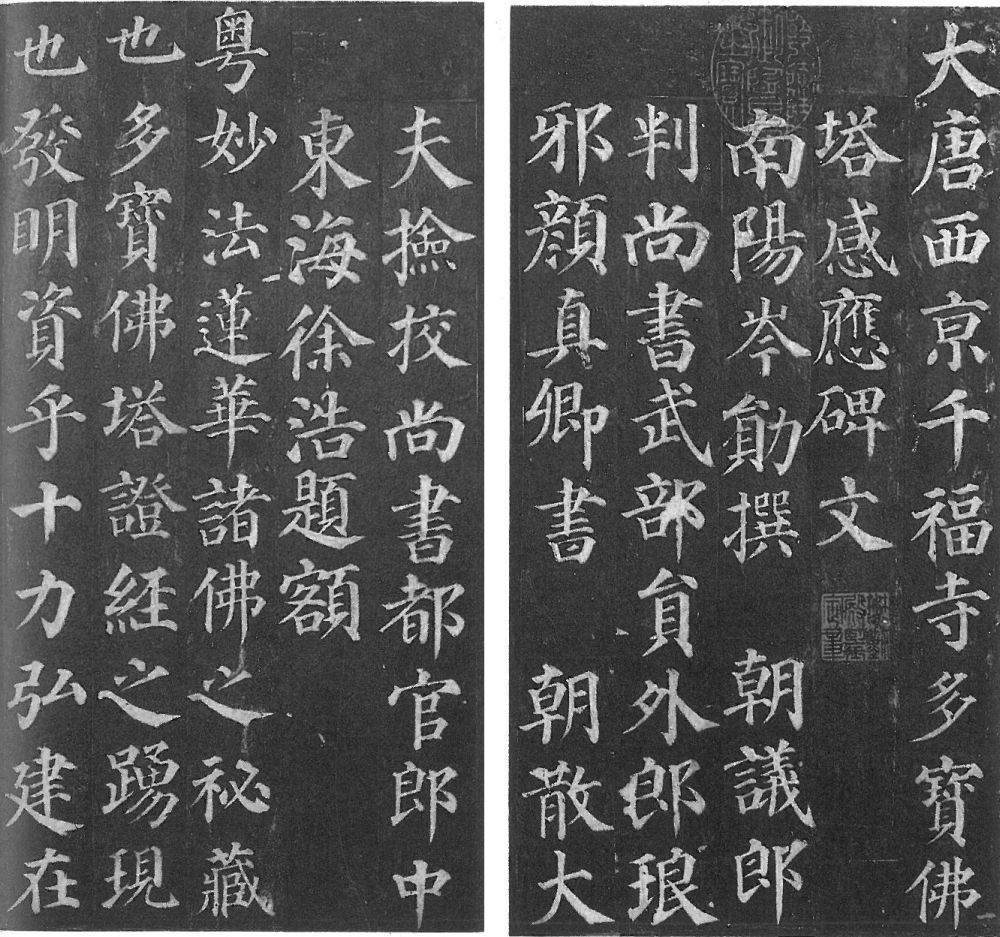 |
Yan Zhenqing's 顏真卿 calligraphy incised into a stele close to the Duobao Pagoda (Duobaota Ganying bei 多寳塔感應碑) of Qianfu Monastery 千福寺 in the capital Chang'an 長安 (Xijing 西京, today's Xi'an 西安, Shaanxi). Zhongguo meishu quanji bianji weiyuanhui 3: 142, no. 62. |
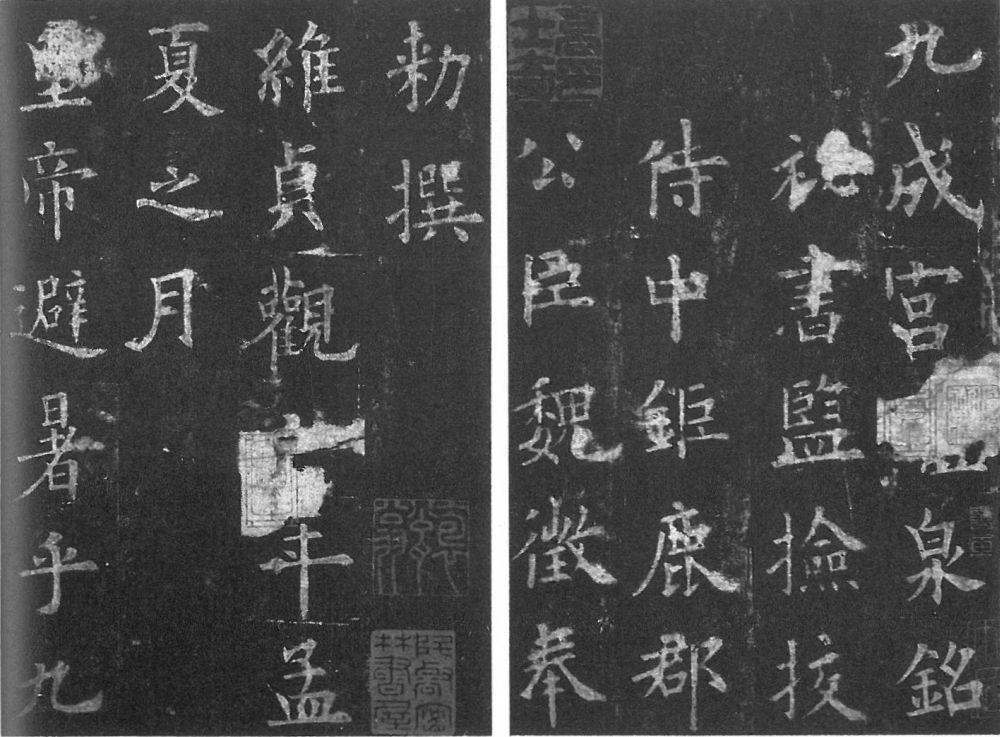 |
Ouyang Xun's 歐陽詢 inscription on the "sweet wine source" of Jiucheng Palace Jiuchenggongo Liquan ming 九成宮醴泉銘. Zhongguo meishu quanji bianji weiyuanhui 3: 38, no. 21. |
The "running script" (xingshu 行書) is a writing style between the ultra-cursive (caoshu 草書) and the regular script (kaishu). It is characterized by a fusion of separate brush strokes and minor changes of shape and sequence of brush strokes. It is easier to read than caoshu and is therefore very widespread in daily use. The xingshu is in use since the middle of the Later Han period. Its "invention" is traditionally attributed to the Later Han-period master Liu Desheng 劉德升. His disciples Zhong Yao and Hu Zhao 胡昭 (162-250) were famous calligraphers at the court of the Western Jin dynasty 西晉 (265-316).
The xingshu style was most commonly used for documents as well as letters and essays during the Jin period. The most famous xingshu style work of calligraphy is Wang Xizhi's Lantingxu 蘭亭序. Zhong Yao was famous for his mastering the xingshu, bafen and zhenshu. The xingshu was mostly used for private communication, and the most famous and artful examples of xingshu calligraphy are private letters. A special ductus of the xingshu is the zhenxing 真行 style, a mixture of the zhenshu (kaishu) and the xingshu.
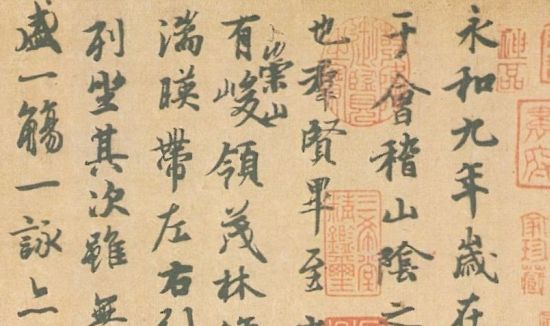 |
Wang Xizhi's 王羲之 famous Lantingxu 蘭亭序. Zhongguo meishu quanji bianji weiyuanhui 2: 90, no. 54. |
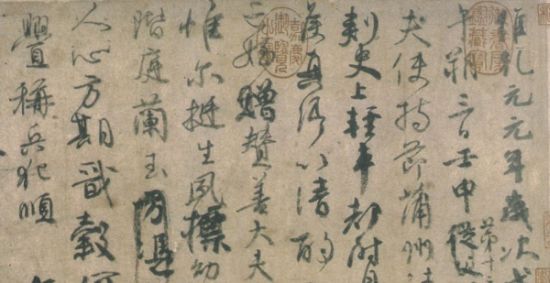 |
Yan Zhenqing's 顏真卿 Ji zhi wengao 祭姪文稿. Zhongguo meishu quanji bianji weiyuanhui 3: 154, no. 69. |
The "grass script" (caoshu 草書) is a writing style that developed during the Han period. During the Tang period, three styles were discerned, the zhangcao 章草 "isolating or distinct grass script", 今草 "modern grass script" and 狂草 "mad grass script". Typical examples of the zhangcao are Huang Xiang's 皇象 Jijiuzhang 急就章 (a calligraphy of Shi You's 史游 Jijiupian 急就篇), for the jincao Wan Xizhi's Chuyue 初月 and Deshi 得示 as well as Sun Guoting's 孫過庭 Shupu 書譜, and for the kuangcao Zhang Xu's 張旭 Dutong 肚痛, Huaisu's 懷素 Zixutie 自敘帖 or Huang Shangu's 黃山谷 Li Bai yi jiu you shi 李白憶舊游詩. The creation of cursive styles is as old as the Chinese script itself, and some famous persons like Qu Yuan 屈原 (late Warring states period) and Dong Zhongshu 董仲舒 (Former Han period) are credited with the creation of a standard draft script (gaoshu 藁書). Liu Mu 劉睦, Prince Jing of Beihai 北海敬王, and Du Du 杜度, counsellor to the prince of Qi 齊, are said to have invented the proper caoshu´ script during the Later Han period. Yet archaeological findings prove that there were already many abbreviations of brush strokes in use during the late Former Han period. The caoshu was already a proper writing style at the beginning of the Later Han period. The late Han period dictionary
A famous master of the caoshu script was the late Han calligrapher Zhang Zhi 張芝. He was followed by Zhong Yao 鍾繇 somewhat later. The caoshu was so prevalent at the end of the Han period that Cai Yong and Zhao Yi 趙壹 fulminated against the use of it and defended the standard script. The name zhangcao 章草 "distinct or isolating grass script" is probably derived from the use not yet to connect one character with the other, but, as in the standard script zhangshu 章書, each character was separately written. That the term zhangcao 章草 is derived from the name of Emperor Zhang 漢章帝 (r. 75-88) as the patron of the script or from the name of the essay Jijiuzhang 急就章 is quite improbable. The "modern grass script" jincao , used during the Southern Dynasties and the Tang periods, might have originated together with the development of the kaishu style. This style, promted by Cui Yuan 崔瑗, Wang Xizhi 王羲之 and Wang Qia 王洽, already connects each character with the following so that whole phrases are written in one single period. The "mad grass script" is a product of calligraphers and can rarely be used in daily life because the characters are abbreviated to such an extent that they are hardly to identify.
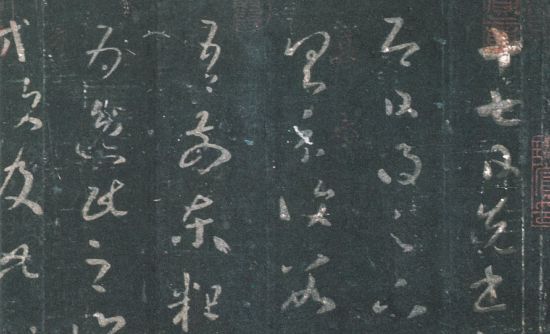 |
Rubbing of an engraving of Wang Xizhi's 王羲之 Shiqi tie 十七帖, performed in "modern grass script" (jincao 今草). Zhongguo meishu quanji bianji weiyuanhui 2: 94, no. 56. |
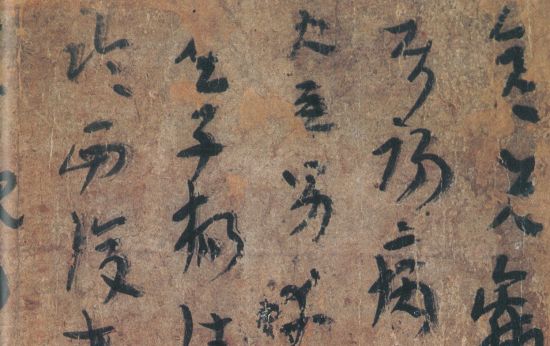 |
Lu Ji's 陸機 calligraphy Pingfu tie 平復帖, written in separate-character or isolating grass script (zhangcao 章草), which does not combine one word and the next. Zhongguo meishu quanji bianji weiyuanhui 2: 48, no. 30a. |
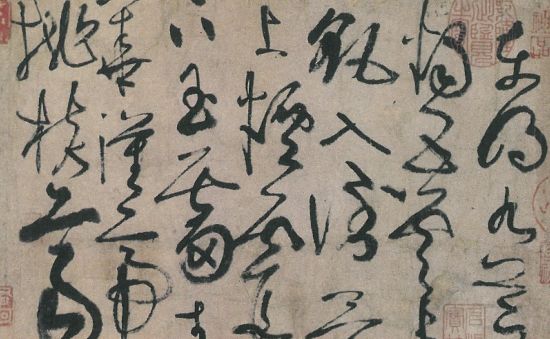 |
An extraordinary example of "mad grass script" (kuangcao 狂草), in which characters are combined: Zhang Xu's 張旭 Gushi si tie 古詩四帖. Zhongguo meishu quanji bianji weiyuanhui 3: 112, no. 52. |
Apart from these writing styles, there are also lots of ornamental and magical scripts, like the "jade chopstick script" (yujin zhuan 玉筋篆), the "lucky mushroom script" (zhiying zhuan 芝英篆), the "bell and tripod seal script" (zhongding zhuan 鍾鼎篆), the "dropping dew seal script" (chuilu zhuan 垂露篆), and so on.
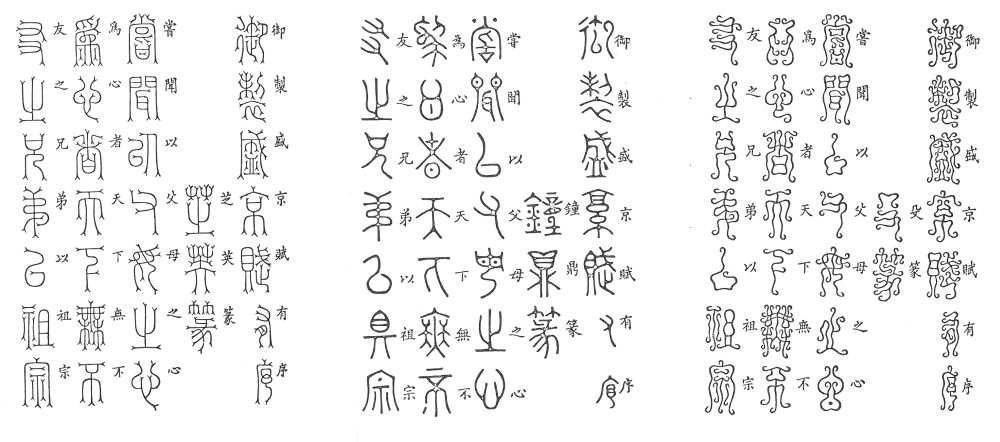 |
Ornamental scripts, namely the "mushroom script" (zhiying zhuan 芝英篆), bells-and-tripods script (zhongding zhuan 鐘鼎篆), and the war-club script (shuzhuan 殳篆), from left to right. The text is the beginning of the preface to the rhapsody "Ode of Mukden" (Shengjing fu 盛京賦) composed by the Qianlong Emperor 乾隆帝. From Stary 1980: 26, 38, 50. |